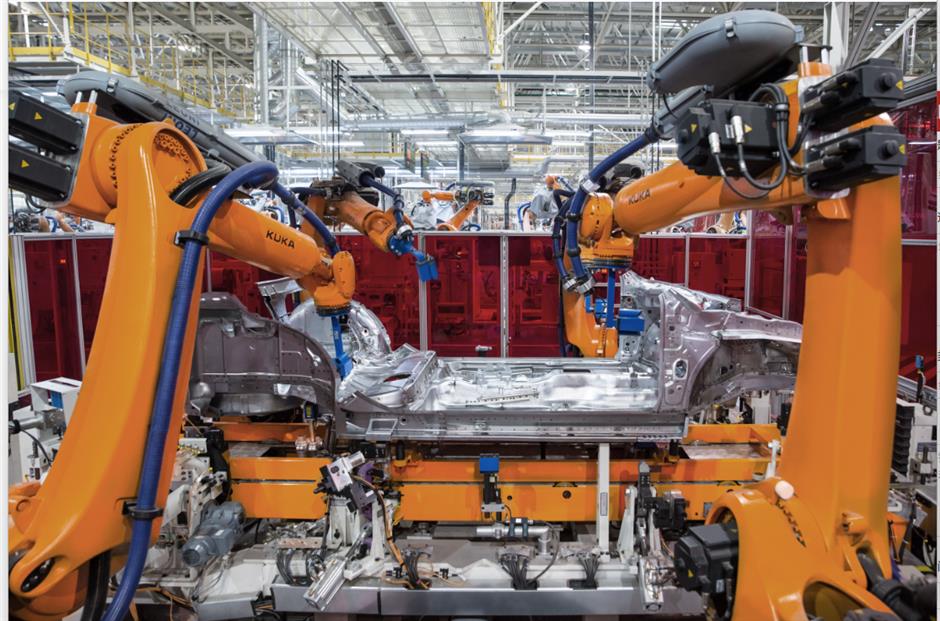

SAIC Volkswagen's Jiading plant runs at high capacity.
Emerging industries, auto sector ensure steady growth
Jiading's industrial economy grew steadily in the first half of 2025, underscoring both resilience in traditional sectors and accelerating momentum in strategic emerging industries.
The district recorded a total industrial output of 220.84 billion yuan (US$30.4 billion) from January to June, up 4.8 percent year over year.
Output from strategic emerging industries reached 77.11 billion yuan, accounting for 34.9 percent of above-scale enterprises, while the auto sector continued to dominate, contributing 141.79 billion yuan, a 7 percent increase from a year earlier.
The auto sector added 4.2 percentage points to Jiading's overall growth, with a contribution rate exceeding 85 percent. SAIC Volkswagen's Jiading plant maintained high-capacity production with fully automated assembly and logistics systems.
The company has accelerated its "oil-electric-intelligent" strategy, introducing upgraded SUV models and expanding its new energy portfolio with the launch of the Audi A5L Sportback and the pending debut of the electric Audi E5 Sportback.
From January to July, SAIC Volkswagen's terminal sales reached 605,000 units, up 1.1 percent year-on-year.
Global auto parts supplier Aptiv also reported stable performance. Its Q2 revenue reached US$5.2 billion, a 3 percent increase, while its first-half revenue totaled US$10 billion, up 1 percent year over year. In Jiading's Anting Town, Aptiv has launched a 500-million-yuan investment project focusing on high-voltage distribution systems for new energy vehicles, expected to generate well over 10 billion yuan in sales within a decade.
Emerging sectors helped inject "new energy" into Jiading's growth. High-end equipment, biomedicine, new-generation information technology and new materials all reported expansion. Biomedicine output rose 9.3 percent, new materials climbed 7.3 percent, and information technology grew 11.1 percent.
Nanya New Material Technology Co, a key high-tech enterprise, posted revenue of 2.305 billion yuan in the first half, a 43.1 percent jump, with net profit up 57.7 percent. The company's high-speed electronic materials have entered AI servers, supercomputers, and general server markets, securing orders from major technology companies.
Hesai Technology also expanded rapidly, with lidar production climbing over 35 percent year on year. The company is targeting an annual capacity of 2 million units in 2025 to meet demand in global autonomous driving and robotics markets.
Traditional enterprises also showed renewed strength.
Kaiquan Pump Co's output rose 12 percent year on year in the first half, supported by digital upgrades and overseas expansion.
"We will continue to deepen our international strategy and enhance China's position in the global pump industry," said Xu Xiaohui, vice president of Kaiquan.
Demand for P4 series fuel cell system is on the rise
The independently developed P4 series fuel cell system by Shanghai Hydrogen Propulsion Technology Co, a key enterprise in the hydrogen energy field in Jiading District, was delivered to the United States for the first time and applied to the local hydrogen energy mobile charging vehicle project early this year.
Recently, the company has secured bulk orders for this project and started supplying goods in batches and small quantities.
Hydrogen energy mobile charging vehicles are an important supplementary form of electric vehicle charging. They feature high mobility, environmental friendliness and low carbon emissions, and can effectively reduce the installation cost and floor space of charging facilities. Among them, the fuel cell system is like the "heart" of the mobile charging vehicle and a core component for its safe and reliable operation.
Buses in various districts of Shanghai have installed the company's fuel cell systems, which have operated safely for many years.
Meanwhile, the "New Long March" hydrogen energy heavy truck, equipped with the essential hydrogen power technology provided by GWM Hydrogen-FTXT, has arrived in Brazil. It has become the first hydrogen energy heavy truck introduced by Brazil, injecting "Chinese hydrogen power" into the local green upgrade of transportation.
This is a key step to respond to the Great Wall Group's globalization strategy and deepen China-Brazil hydrogen energy cooperation.
Great Wall Group and GWM Hydrogen-FTXT have a long-standing connection with Jiading's Anting Town. Anting has taken Jiading Hydrogen Energy Port as the core carrying area for the development of the hydrogen energy industry and focused on the early planning and layout of the hydrogen energy and fuel cell vehicle industry.
Innovation hub displays cutting-edge technology
Have you seen a humanoid robot somersault using its "brain" and "cerebellum" or a snake-like robot with "twists and turns" and a robotic needle capable of "threading a needle?"
Jiading District's International Innovation Center for Smart Manufacturing and Robotics has them all.
The center in Nanxiang Town receives several groups every day. Professional visitors come here to learn about the cutting-edge trends in the development of the smart manufacturing and robotics industry and seek corporate cooperation.
As a key platform for technological innovation and industrial upgrading in Nanxiang, the center is rooted in Jiading's strengths.
With a physical space of 10,000 square meters, the co-innovation center connects upstream and downstream industries, fostering collaborative innovation among industrial chains.
Here, companies are in-depth partners. Enterprises are working together in areas like smart technology, brain controllers for humanoid robots and joint modules, which are greatly boosting the center's growth.
Up to now, the center has introduced more than 70 enterprises covering the upper, middle and lower reaches of the smart manufacturing and robotics industrial chain, forming a complete industrial ecosystem closed loop with an industrial scale of around 500 million yuan (US$70 million).
Gao Fei, director of industrial services at the center, said: "We hope to bring our robots from the laboratory to real scenarios and then introduce mature robot companies in the market."

